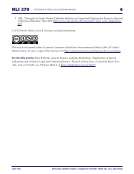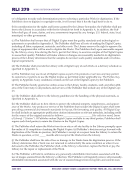June 2012 Research Library Issues: A QuarterlLy Report from ARL, CNI, and SPARC
RLI 279 19
Copyright Risk Management
Four Strategies for Evaluating Risk
The first strategy for evaluating the risk associated with a digitization project is to recognize that, in
many collections, at least some of the material will be in the public domain. This recognition helps us
reduce, in our perception of a project, the number of risky items involved. As has been noted, the public
domain is usually considered, in digitization planning, only when an entire collection is likely to be in
the public domain. That means that all of the material must be published before 1923 or unpublished
and created by persons who died prior to 1940.5 But mixed collections of 20th-century material will
also contain public-domain materials, although determining exactly which items are which may be
difficult. Publication date and creator’s death date are usually discoverable what is more difficult is the
determination of the copyright status of materials published between 1923 and 1989. John Wilkin has
written a comprehensive analysis of this problem, which he calls “bibliographic indeterminacy.”6
Indeterminacy is only a problem, however, if one is seeking certainty. From the perspective of risk
management, it is enough to recognize that most collections of 20th-century materials will contain some
public-domain materials. Some materials, for example, will have been published between 1923 and
1963 without copyright notice, or will not have had their copyrights renewed. This category of works is
estimated to include about 55% of the books published during this period,7 and it will often be true of
newspaper or magazine clippings as well. Another group of materials will be works of the US federal
government, which are not eligible for copyright protection. Amongst the unpublished works in a given
collection, such as letters, some will have been created by people who have been dead more than 70
years. Once a risk-management approach is adopted, these categories can be seen as broad groupings
that reduce the number of risky items in a potential digital collection. Even though exact determinations
cannot be made, recognition of the categories and their potential application is an important step in
deciding with some accuracy how risky or safe a particular proposal may be.
The second strategy for risk management in digitization projects is to ask permission from the people
or organization that would be most likely to object to the digital display. Again, we should recognize that
it will usually be impossible or impractical to identify every rights holder and ask permission, and no
project need depend on meeting such an impossible standard. The principle of reducing the number of
people likely to sue suggests that asking permission even from only a few rights holders, especially those
who seem likely to hold rights in a substantial portion of the included material, is an important step in
risk management. If there is a large number of clippings from a particular newspaper whose publisher
still exists, or a large number of letters by a single author whose heirs can be identified, these are good
candidates for permission. Literary estates, which often police the use of works by a particular author,
are also good candidates for permission. But it cannot be emphasized too often that asking permission
from some large or prominent rights holders does not mean that permission must be obtained for every
item in a digital collection. The goal is to reduce the number of likely plaintiffs and to head off those who
seem most likely to object as part of an overall risk-management strategy. This approach can significantly
increase confidence without creating an insurmountable obstacle.
Also stemming from the principle of reducing potential plaintiffs is a third strategy of having, in
advance, a take-down policy for any materials made subject of a complaint. Digital collections generally
RLI 279 19
Copyright Risk Management
Four Strategies for Evaluating Risk
The first strategy for evaluating the risk associated with a digitization project is to recognize that, in
many collections, at least some of the material will be in the public domain. This recognition helps us
reduce, in our perception of a project, the number of risky items involved. As has been noted, the public
domain is usually considered, in digitization planning, only when an entire collection is likely to be in
the public domain. That means that all of the material must be published before 1923 or unpublished
and created by persons who died prior to 1940.5 But mixed collections of 20th-century material will
also contain public-domain materials, although determining exactly which items are which may be
difficult. Publication date and creator’s death date are usually discoverable what is more difficult is the
determination of the copyright status of materials published between 1923 and 1989. John Wilkin has
written a comprehensive analysis of this problem, which he calls “bibliographic indeterminacy.”6
Indeterminacy is only a problem, however, if one is seeking certainty. From the perspective of risk
management, it is enough to recognize that most collections of 20th-century materials will contain some
public-domain materials. Some materials, for example, will have been published between 1923 and
1963 without copyright notice, or will not have had their copyrights renewed. This category of works is
estimated to include about 55% of the books published during this period,7 and it will often be true of
newspaper or magazine clippings as well. Another group of materials will be works of the US federal
government, which are not eligible for copyright protection. Amongst the unpublished works in a given
collection, such as letters, some will have been created by people who have been dead more than 70
years. Once a risk-management approach is adopted, these categories can be seen as broad groupings
that reduce the number of risky items in a potential digital collection. Even though exact determinations
cannot be made, recognition of the categories and their potential application is an important step in
deciding with some accuracy how risky or safe a particular proposal may be.
The second strategy for risk management in digitization projects is to ask permission from the people
or organization that would be most likely to object to the digital display. Again, we should recognize that
it will usually be impossible or impractical to identify every rights holder and ask permission, and no
project need depend on meeting such an impossible standard. The principle of reducing the number of
people likely to sue suggests that asking permission even from only a few rights holders, especially those
who seem likely to hold rights in a substantial portion of the included material, is an important step in
risk management. If there is a large number of clippings from a particular newspaper whose publisher
still exists, or a large number of letters by a single author whose heirs can be identified, these are good
candidates for permission. Literary estates, which often police the use of works by a particular author,
are also good candidates for permission. But it cannot be emphasized too often that asking permission
from some large or prominent rights holders does not mean that permission must be obtained for every
item in a digital collection. The goal is to reduce the number of likely plaintiffs and to head off those who
seem most likely to object as part of an overall risk-management strategy. This approach can significantly
increase confidence without creating an insurmountable obstacle.
Also stemming from the principle of reducing potential plaintiffs is a third strategy of having, in
advance, a take-down policy for any materials made subject of a complaint. Digital collections generally
























